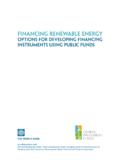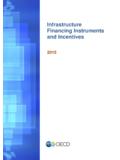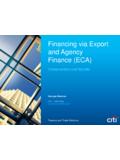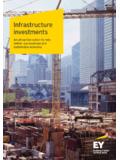Transcription of Convening Report - The Johnson Foundation at Wingspread
1 January 2012 financing Sustainable Water InfrastructureConvening Report 2012 Published by The Johnson Foundation at Wingspread Racine, Wisconsin Printed on post-consumer recycled paperMeeting Convened by American RiversCeresThe Johnson Foundation at WingspreadJuly August, 2011 financing Sustainable Water InfrastructureConvening Report1 Convening Report financing Sustainable Water InfrastructureExecutive Summary ..2 Report Process ..5 Background ..6 The Challenges We Face: Obstacles to Transforming Our Water Systems ..13 Opportunities and Solutions: Sustainable financing for Sustainable Infrastructure ..19 Steps for Creating Change ..24 Commitments ..26 Attachments ..29 Attachment A: Background Materials ..29 Attachment B: Concept & Background ..30 Attachment C: Wingspread Meeting Program ..33 Attachment D: Meeting Participants ..35 Contents2 Convening Report financing Sustainable Water InfrastructureOur nation s freshwater infrastructure faces a critical juncture.
2 Largely built on systems developed during the 19th and early 20th centuries, our water infrastructure is aging, our technology outdated and our governance systems ill equipped to handle rising demand and environmental challenges . Additional strain is being placed on these systems from a variety of sources, including pressures from urbanization and changing climate conditions, such as increases in both droughts and extreme one-day precipitation events. While these challenges are significant, they are not insurmountable. In fact, they can be viewed as drivers of much-needed change in how we finance and develop our water systems to meet future demands. New financing models and pricing flexibility, which are necessary to pay for new infrastructure and to support legacy systems, provide enormous opportunity for positive transformation necessary to keep pace with the rapid changes being experienced by counties, municipalities and investor owned Report seeks to tackle these issues and deliver some recommendations on how to understand and confront the pressing need for more sustainable and integrated water infrastructure financing models.
3 This Report is the product of a meeting convened by The Johnson Foundation at Wingspread , in collaboration with American Rivers and Ceres, which brought together a group of experts to discuss ways to drive funding toward the infrastructure we need for the 21st century. Specifically, this group focused on the following questions: What new financing techniques can communities use to pay for integrated and sustainable infrastructure approaches? How can we direct private capital toward more sustainable water management projects? The Report finds that while options for more cost-effective, resilient and environmentally sustainable systems are available, they are not the norm. In fact, investment in inflexible and expensive siloed water systems is still pervasive, despite the fact that money available for financing water infrastructure is increasingly equal concern is the inefficiency of the existing systems, which lose some 6 billion gallons of expensive, treated water each day due to leaky and aging pipes some 14 percent of the nation s daily water use.
4 This point is underscored by the fact that the American Society of Civil Engineers gives the nation s water systems a D-, the lowest grade of any infrastructure including roads and Summary3 Convening Report financing Sustainable Water InfrastructureThe Report also details the various financing mechanisms available to different water systems. While municipal bonds are the debt instrument of choice for utilities large enough to be able to attract capital from markets, the vast majority of water systems must rely on cash, state revolving loan funds, or other low-interest loan programs at the state and federal level. In fact, only about 1,500-2,000 of the roughly 52,000 water systems in the United States are large enough to issue their own bonds. Given these constraints, some systems are turning to private equity as a financing are, of course, numerous obstacles and challenges that stand in the way of transforming our water systems to ones that are more sustainable, resilient and cost-effective.
5 One of the main impediments to change is the very nature of the systems themselves, where potable water, wastewater, stormwater, greywater and rainwater are not treated as part of an interconnected system, but rather as distinct, separately financed and regulated addition, the rate-paying public and locally elected officials must come to grips with the temporary nature of federal subsidies for infrastructure. Once these subsidies expire, ratepayers are left holding the bag for funding further maintenance, inspection and upkeep, which can be politically unpopular. Therefore, many jurisdictions are not able to fully recapture all relevant costs, leading to long-term financial shortfalls and suboptimal maintenance and upkeep of systems. While these challenges and obstacles are formidable, the Report makes clear that they are not insurmountable.
6 Progress towards more sustainable, resilient and cost-effective systems is attainable, particularly if a long-term view is taken. While there is no silver bullet, the Report outlines pathways that will improve chances of success. These include: Recognize that local pressures will drive local solutions . Our water systems are as diverse as the drivers of change that impact them. But solutions are emerging at the local level, including green infrastructure, closed loop systems and recycling. financing models need to be developed that can support this type of local activity, which can then be scaled up. Consumers should be given choices and options . Today s water systems typically provide one product at a single price focusing on potable water. While that has served us well, it is also true that potable water is the most expensive kind of water and is widely used for non-drinking purposes such as watering lawns, flushing toilettes and showering.
7 Consumers should be given options that include differentiated rates for drinking water versus other types. Additionally, water systems should explore how to move beyond minimum cost rates in order to meet customer Report financing Sustainable Water Infrastructure The financial health of our water systems is directly linked to their long-term sustainability . Our nation s water systems need to embrace various financing changes in order to ensure long-term sustainability. These include full-cost accounting of water services; incorporating value-added services into the revenue picture to better align customers perceived value with products delivered; improving the capture and dissemination of performance data to drive efficiency; and considering consolidation of certain systems to enhance efficiency. Innovative financing models should be pursued to increase efficiency, add value to customers, and lower costs for providers.
8 These models should include: mechanisms to expand the pool of water service funding to non-traditional partners; increasing incentives and markets for distributed water services that include low impact development, such as on-site treated wastewater for buildings; and other green infrastructure initiatives. Alternative market-based solutions should be explored and evaluated for scalability . These solutions could include: properly valuing and pricing ecosystems services, which provide enormous value yet are largely unaccounted for in the present system; developing securities to aggregate customer-financed projects such as greater where it falls water management; and creating private investment opportunities for efficiency gains from such things as retrofitting and closed-looped water systems in order to reduce system impacts and improve efficiency at both the building and neighborhood summary provides an overview of the main sections and themes contained in the Report , but is not a substitute for the full breadth of depth offered in the following Report financing Sustainable Water InfrastructureReport ProcessThe Johnson Foundation , in collaboration with American Rivers and Ceres, convened a group of experts at Wingspread to discuss ways to leverage public funding and incentives as well as private financing to drive innovation and resources toward more sustainable and integrated management of water resources in the United States.
9 This meeting was set apart from similar efforts to discuss water infrastructure systems by the unique mix of expertise represented. Public and private water utility managers, investment managers, investors, municipal bond raters and underwriters, non-governmental organizations, foundations and other stakeholders gathered to discuss the range of issues being faced and begin to chart the pathways toward innovative and sustainable funding mechanisms that support the long-term sustainability of our water systems both built and natural. The needs of communities vary significantly even though their challenges are similar. There is not a consistent approach that will work for all, rather a range of options and tools that allow for customized approaches that meet a range of interests. The shift toward a more sustainable and economically viable future will not likely be driven primarily by sweeping legislation or legal mandates, but by thousands of local infrastructure investment decisions.
10 If those decisions are going to result in a more sustainable future, utilities must look for a portfolio of financing alternatives at the same time they are developing alternatives for more resilient systems. The Convening was designed around three elements of a facilitated dialogue process. Two virtual convenings and one in-person meeting were conducted during the summer of 2011 as follows: Webinar 1, July 26, 2011: What is Sustainable Water Infrastructure? Webinar 2, August 10, 2011: Unpacking the financing Options In-person Convening at The Johnson Foundation at Wingspread , Racine, Wisconsin, August 16 18, 2011 Commitments to actionA unique component of this meeting was that each of the participants offered to advance solutions to the issues brought forth in the conference by committing to specific actions. Those commitments are included in this Report financing Sustainable Water InfrastructureSource: World Meteorological Organization (WRO), Geneva, 1996, Global Environmental Outlook (GEO), 2000, United Nations Environment Programme (UNEP), Earthscan, London, 1999.






